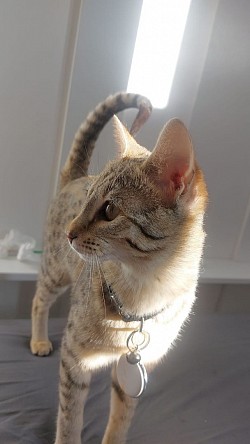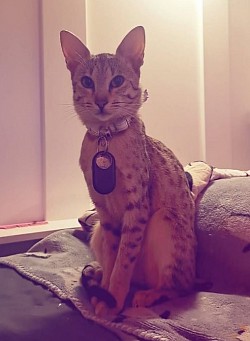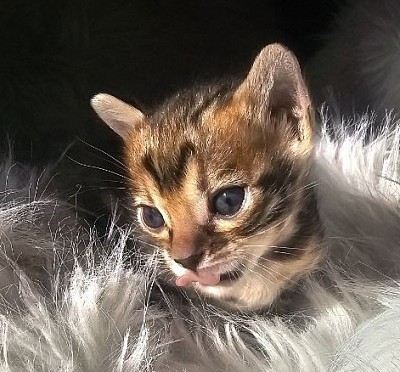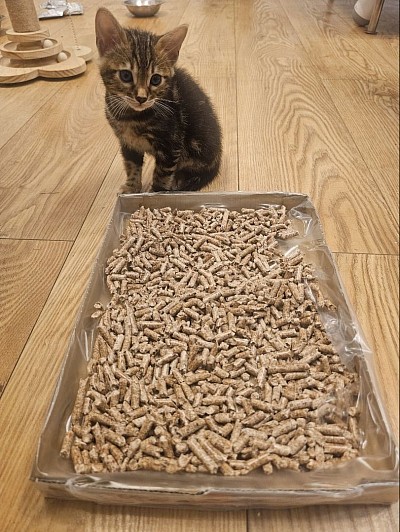Comprehensive Kitten Information Guide
Kitten Information Overview
Kitten Information Sheet
Congratulations on the addition of your new Bengal/Savannah kitten. This document provides essential information about your kitten and offers guidance to support you during the initial weeks of ownership.
Medical Information
Your kitten has received all necessary vaccinations and deworming treatments before joining your household. The administered treatments are detailed below:
Deworming Schedule
Initial Dewormer: Milbemax
Age Frequency Notes
3 weeks old First dose Commence deworming
Every 2 weeks until 8 weeks old Regular schedule Controls common intestinal parasites
Monthly until 6 months old Ongoing protection is particularly important for kittens with outdoor exposure
Every 1–3 months thereafter Maintenance is adjusted according to lifestyle and risk factors
Cat Vaccination Schedule
Age (Weeks) Annual Core Vaccines Noncore Vaccines
6–8 weeks — FVRCP FeLV*
10–12 weeks — FVRCP FeLV*
14–16 weeks — FVRCP, Rabies** FeLV*
Every year thereafter ✔️ FVRCP, Rabies** FeLV* (if indicated)
Notes:
FeLV (Feline Leukaemia Virus):
Highly recommended for kittens and outdoor cats; optional for adult indoor-only cats.
Rabies:
Your veterinarian will establish the appropriate vaccination protocol based on local and state regulations, as well as your cat’s health and lifestyle risk factors.
Feeding
Your kitten is fully weaned and currently consuming solid food. To ensure a smooth dietary transition, it is advisable to continue providing the brands your kitten is familiar with. The current diet consists of:
- Fresh water
- Royal Canin wet food
- Royal Canin kitten biscuits
- Raw chicken, fish, and turkey mince
Your kitten is fully litter-trained and has consistently used a litter box for several weeks. However, relocating to a new environment may cause temporary disorientation, potentially resulting in one or two accidents until your kitten becomes accustomed to the litter box’s location. Please note that adjustment periods may vary among individual cats.
General Information and Recommendations
Upon arrival at its new home, your kitten may display signs of missing its mother and siblings, including vocalisation. This behaviour is normal and typically diminishes within one to two days. Initially, it is recommended to restrict your kitten’s access to limited areas of your home, gradually expanding their range as they become more comfortable.
Bengal and Savannah cats are notably curious about water. To ensure their safety, please prevent access to unattended water sources such as bathtubs and toilets, as they may attempt to explore or swim.
Regular interactive playtime is essential for your kitten’s development. Bengals and Savannahs are intelligent and quick learners who enjoy activities such as hiding in cardboard boxes or tunnels and playing “stalk the owner.” They also often enjoy playing fetch with rolled-up paper balls.
Several reputable websites provide extensive information about the Bengal breed, which can serve as valuable resources. Should you have any questions or require further assistance, please do not hesitate to contact me.
Caring for Your Bengal or Savannah Kitten
Bringing Your Kitten Home – What to Expect
Welcoming your new Bengal or Savannah kitten into your home is an exciting experience, though it may also bring some concerns. You are now responsible for a young cat who is still exploring his environment. While kittens bring joy and energy to your household, it is essential to prepare your home for their arrival and understand what to anticipate.
Bengal and Savannah kittens are notably curious, enjoying exploration, hiding, pouncing, and investigating their surroundings. Therefore, it is vital to remove potential hazards before bringing your kitten home. Start by ensuring all windows and doors are securely closed. For the first few months, your kitten should remain indoors to learn that this is his home, where food and water are provided.
An open door or window could result in your kitten wandering outside and becoming lost. Additionally, block any spaces where your kitten might become trapped. It is advisable to confine your kitten to a single room for several days until he consistently uses the litter tray and is familiar with the locations of his food and water.
Your kitten will likely choose his own sleeping area; however, he may appreciate a small, cosy cat bed with a hot water bottle filled with warm (not hot) water beneath a blanket. Having never been separated from his mother and siblings, this will provide comfort during the transition.
Undoubtedly, your Bengal or Savannah kitten will be energetic, playful, and inquisitive, so close supervision during the initial weeks is strongly recommended.
Introducing Your Kitten to Children and Pets
When introducing your kitten to children and other pets, it is crucial to proceed with caution. While your Bengal or Savannah kitten can form strong bonds, a poorly managed introduction may negatively affect future relationships.
Children often become overly excited about new pets, so it is important to teach them that kittens are not toys and must be handled gently. Limit interactions to brief, positive sessions. Remember, kittens do not yet understand that biting is inappropriate and may nip children. This behaviour can be redirected by encouraging mouthing on toys instead.
Bengals and Savannahs exhibit dog-like personalities and generally adapt well to cat-friendly dogs. Allow introductions to progress at your kitten’s pace, and during the initial weeks, manage your dog’s excitement when they share a room.
Introducing your Bengal or Savannah to an existing cat may present more challenges. Most cats, except Bengals and Savannahs, tend to be less sociable and prefer their own space. If you have a resident cat of a different breed, provide ample space for both cats to retreat, and place litter trays and food and water bowls in separate rooms to avoid sharing.
Your Kitten’s Diet
The variety of cat foods available can be overwhelming. However, focusing on key factors will ensure you provide a high-quality diet for your kitten.
When collecting your kitten from the breeder, inquire about the food he has been consuming, as it is best to maintain the same diet for a couple of weeks to ease his transition. After this period, you may switch to a kitten-specific food of your choice. It is essential to feed kitten-formulated food, as adult cat food lacks the appropriate levels of calcium, phosphorus, and protein necessary for growth.
Both wet and dry foods have advantages and disadvantages. Dry food supports dental health by reducing plaque through the mechanical action of chewing. Conversely, wet food is generally more palatable and provides additional hydration, which helps prevent cystitis, a common feline condition. The breeder provides both options.
When selecting flavours, prioritise the primary ingredient listed. It should be a high-quality, ethically sourced, meat-based protein. Fish is particularly beneficial, offering not only excellent protein but also omega-3 and omega-6 fatty acids that promote a shiny coat and healthy skin barrier.
Parasite Treatment
Your kitten should have been dewormed by the breeder at 3, 6, 8, and 12 weeks of age to protect against roundworms. Subsequently, deworming should occur every three months for outdoor or hunting cats, and every six months for indoor cats. Treatments should cover both roundworms and tapeworms and are available in various forms, including paste, tablets, treats, or spot-on pipettes.
Preventative flea treatment is essential for outdoor cats or households with other pets if your Bengal or Savannah is indoor-only. Follow the medication’s recommended frequency, which may range from monthly to every six months. Flea prevention options include spot-on pipettes, tablets, sprays, or injections.
Vaccinations
Vaccinating your kitten is critical, regardless of whether he will be an indoor or outdoor cat. The initial vaccination series consists of two injections administered three to four weeks apart, starting as early as eight weeks of age. Annual booster shots are required thereafter.
The vaccine comprises two components:
- Feline flu and enteritis: This combination vaccine protects against feline panleukopenia virus (FPV, feline infectious enteritis), feline herpesvirus (FHV-1, cat flu), and feline calicivirus (FCV, cat flu).
- Feline leukaemia virus (FeLV): Typically included with the flu and enteritis vaccine, this component is recommended for all cats. Some owners opt out if their cat remains strictly indoors. Despite ancestral resistance in Bengals, they remain susceptible to FeLV.
Neutering
Neutering is recommended for all cats not intended for breeding, especially those with outdoor access.
Males can be castrated once both testicles have descended. The procedure lasts 5-10 minutes, with discharge a few hours later. Castration prevents testicular cancer, reduces roaming and associated traffic risks, decreases spraying, and lessens territorial aggression.
Females can be spayed at the same age. This slightly longer procedure takes no more than 20 minutes. Some veterinarians perform the spay via a flank incision, while others use a midline abdominal approach. Both methods yield similar outcomes and recovery times. Note that hair regrowth may differ in colour, especially in lighter-colored Bengals and Savannahs; request a midline incision if you prefer to conceal this. Spaying is crucial for outdoor females to prevent unwanted litters and reduce calling behaviour during estrus.
Microchipping
While microchipping is legally required for dogs in the UK, it is not mandatory for cats. Nonetheless, microchipping your Bengal or Savannah kitten is highly recommended, regardless of indoor or outdoor status. Should your cat become lost, microchipping facilitates prompt reunion. Bengals and Savannahs are particularly prone to losing collars due to their inquisitive nature, making microchips a reliable form of identification when kept up to date.
Additionally, Bengals and Savannahs are highly sought after by thieves due to their striking pedigree status and high market value. Microchipping enhances the likelihood of recovery and aids in apprehending perpetrators.
Allowing Your Kitten Outside for the First Time
After your kitten has been vaccinated, neutered, and acclimated to your home for several months, you may permit supervised outdoor access, ideally in your garden. Choose a day with favourable weather and a time when your kitten is somewhat hungry to encourage a prompt return indoors.
Following several supervised outings, ensure microchip recognition and exclusive access for your cat.
Engaging in Play with Your Kitten
Bengal and Savannah kittens are exceptionally playful, having previously engaged in play with their mother and littermates. Expect your new kitten to seek interactive play with you upon arrival.
Encourage play with toys rather than your fingers or toes. While playful biting may seem amusing initially, it becomes less tolerable as your kitten matures. Toys that can be thrown and pounced upon provide endless amusement.
Given their high intelligence, Bengals and Savannahs benefit from more stimulating toys, such as treat-dispensing puzzles that challenge them to earn rewards.
Your Bengal or Savannah will be sociable and may attempt to engage other pets in play. Some dogs and cats tolerate this rough play, while others may become irritated. Supervise interactions closely, and if another pet shows discomfort, redirect your kitten’s attention to toys. Over time, your kitten will learn that playing with you is more enjoyable.
Kitten Litter Training Guide
Kittens have a natural inclination to use a litter box, making litter training relatively straightforward. Follow this step-by-step guide to effectively train your kitten to use the litter box.
Unlike puppies, which require continuous house training, most kittens instinctively seek out loose materials—such as dirt or scoopable litter—to cover their waste. Nevertheless, gentle guidance can significantly facilitate the litter training process.
Essential Items for Litter Training a Kitten
Kitten-sized litter box
Kitten-appropriate litter
A scooper for removing waste
Plastic or compostable bags for waste disposal
Step-by-Step Guide to Litter Training a Kitten
1. Select Appropriate Locations for Litter Boxes
Location is critical for successful litter training. Cats prefer privacy and easy access, so placing litter boxes in low-traffic areas that are easy to locate and easily accessible, such as bathrooms, quiet corners of bedrooms or living rooms, or closets with doors left open.
If your home has multiple floors, provide a litter box on each level to prevent your kitten from having to climb stairs when nature calls. The goal is to make the process as convenient as possible.
The area should feel secure to your kitten, offering sufficient visibility so they can monitor their surroundings while using the box. Since using the bathroom is a vulnerable moment for cats, ensuring they feel safe is essential.
Importantly, avoid placing litter boxes near your kitten’s food and water dishes. Just as humans would not want to eat next to a toilet, neither would your kitten.
2. Introduce Your Kitten to the Litter Boxes
Immediately upon bringing your kitten home, guide them to their litter box. Repeat this several times daily to reinforce the location and encourage consistent use.
3. Maintain the Litter Box by Scooping Daily
Your kitten will likely begin using the litter box promptly. To encourage continued use, scoop the litter box once or twice daily. A clean litter box reduces stress for cats of all ages and prevents avoidance due to unpleasant odours or mess.
4. Exercise Patience Throughout the Training Process
Accidents may occur as your kitten learns. It is important to remain patient and avoid scolding, as kittens do not understand punishment and may develop fear or anxiety.
Cats often return to the same spot to eliminate, especially if it retains their scent. To prevent repeated accidents and maintain a fresh environment, thoroughly clean any soiled areas using an enzyme-based cleaner to effectively remove odours.
By supporting your kitten’s natural behaviours, providing appropriate resources, and accommodating any individual preferences, you will set the foundation for successful litter box habits. Wishing you and your kitten a smooth and successful training experience.







